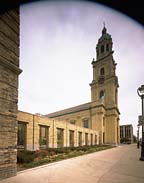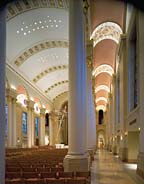
Although the subject of much controversy, the recent renovation of the Cathedral of St. John the Evangelist in Milwaukee, WI, was well received upon its completion. Built more than 150 years ago, the Cathedral was in need of a makeover. Past renovations had revamped the layout of the church and removed a great deal of its intricate marble stonework. With the assistance of an experienced design team and the artful hands of skilled masons, much of the stonework was restored, and today the Cathedral complies with the stringent criteria of the Vatican.
"The Archbishop of Milwaukee established two main goals," said Design Architect Jim Shields of Hammel, Green & Abrahamson of Milwaukee, WI, who worked closely on the restoration with Milwaukee's Cathedral Project Committee led by The Most Reverend Rembert G. Weakland, O.S.B., Archbishop of Milwaukee. "He wanted to remove the negative effects of a 1940s renovation, which had removed the altar from the main worship space, and basically bring the Cathedral into strict conformance with Vatican standards. The other goal was to salvage as much of the existing stonework when possible. I always prefer to do that than throw away anyway. It challenged us to be creative."
According to the architect, a prior renovation following a fire had relocated the altar to 70 feet outside of the central worship area. This accommodated new interior columns that were part of the post-fire rebuilding process. The new altar was brought within 21 feet to where it used to stand, said Shields.
"Historically, from 1847, the altar was placed in the main worship space, only to be removed in a 1943 renovation," he said. "A lot of people were under the impression that what they could see was the original 1800s [design] -- not knowing that it was changed in the 1940s renovation." And for that reason, the new restoration project caused quite a stir among the community. Many parishioners had objected to the changes, because they believed that the "historic" interior should be preserved the way it was.
When the process began to gather all of the existing stonework, all those involved were happily surprised to find more material than they had expected. "The Archbishop wasn't even aware of the extent of it," said Shields. "Down in the earth crawl space we found a communion rail that was removed in 1969. It was just fabulous Italian Rosso Verona marble -- just luscious material. They had little turned doric columns and molding -- all out of Rosso Verona. There were even curved pieces."
The architect explained that he then got the idea to design the Archbishop's chair, the cathedra, using that material. "In looking at those curved pieces, I started to think, 'What can we make of this?,'" he said. "I sketched up the cathedra -- the curved pieces could make the curved back [of the chair]. Basically we were able to build it using almost 90% of the salvaged stone."
The marble cathedra, which weighs a total of 2,000 pounds, sits to the right of the altar and has been elevated on a three-step platform. It has been moved closer to the assembly to provide better visibility.
The new altar, which is comprised of 6,000 pounds of Italian Cremo marble quarried in the Carrara region of Italy, is also partially built of salvaged material. "The Archbishop wanted to scrupulously follow the rules," said Shields. "The Vatican says that there can be only one altar unless others have an historical significance. There were four side altars that were beautiful -- hand-carved out of Carrara marble. They had refined classical ornaments. We had to remove all those that were added in the 1940s."
But to make use of the marble, the columns were re-polished at Milwaukee Marble & Granite's fabrication facility and reinstated as the base of the high altar. A new slab was cut for the top. According to the architect, samples of the columns also were used to help determine what part of the quarry the material had been extracted from. "They cut a new block for the top," said Shields. "It was a flawless 6- x 6-foot slab, which was 4 inches thick."
Further enhancing the look of the altar is a new platform floor and steps, which were built from Tennessee Light Rose marble -- quarried and fabricated by Tennessee Marble Co. of Friendsville, TN. The marble was chosen because it was the same material used for the steps approaching the sanctuary that had to be remodeled.
"[The marble] is relatively a select grade," said Monica Gawet of Tennessee Marble Co. "We don't know who originally sourced it. The options for a perfect match were limited. They literally sent us one of the curved bullnose pieces to match."
According to Gawet, Tennessee Light Rose marble consists of shadings of light and medium pink with no red banding or gray. The material was quarried and fabricated in about a 10- to 12-week period.
Additionally, Italian Cremo marble was used for the ambo, which was cut and hand-carved in Italy to look like an unrolling ancient scroll. According to the architect, the ambo had been designed as a large, gracious reading desk and placed on the same central axis as the baptistery and altar. It is meant to reflect the altar to underscore the connection between the table of the word (the ambo) and the table of the Eucharist (the altar).
Another aspect of the Cathedral's renovation involved moving the baptistery from the southeast corner to the center aisle near the entrance to the building. "We were asked to do a significant baptismal font," said Shields. "We used half salvaged and half new stone for the font. Some new Italian marble -- Rossato -- was cut. They were pretty thick slabs."
The new baptistery was redesigned to include an added feature of a baptismal pool. This will allow the Cathedral to offer both the traditional form of baptism as well as adult immersion. The pool is lined with slabs of Savannah Green granite, according to Shields. "The granite was used for its greater strength and water resistance," he said. Because the Archbishop did not want the drain visible in the pool, it was placed down below the granite. The water comes from the remodeled font and trickles in. There is no sound of water movement.

Skilled craftsman contribute
The Cathedral of St. John the Evangelist shut its doors for less than a year to complete this major renovation. It closed in late May 2001 and reopened in February 2002. Playing a significant role in meeting this tight deadline were the stonemasons who worked on the project."One company really helped us out -- Milwaukee Marble & Granite," said Shields. "Tom Byrnes, the project manager, really has extensive knowledge of marble types. Dave Link came out of retirement to work on the project. He had been working in the Cathedral since the late 1950s on various small projects, during which he had made sure that stonework didn't get thrown out or damaged."
The architect also noted the working foreman, Steve Flegner. "They all did an incredible amount of work," he said. "The level of craftsmanship was pretty amazing."
In total, between six to eight workers were on the job site at one time, according to Project Manager Tom Byrnes, who added that there was also a draftsman who made many of the drawings. "The Cathedral was redesigned in a way that now makes sense in today's world," said Byrnes. "It makes a lot of people a little more comfortable not destroying the history of the building. We went to great lengths to furnish very little new material."
Byrnes explained that Milwaukee Marble & Granite has a long-standing history with the Cathedral. "Some remodeling work was done about 25 years ago," he said. "We were pretty familiar with it."
According to the project manager, one of the company's retired employees had done extensive work in the Cathedral before. He was familiar with what materials were in the original design, and because he didn't always agree with the alterations he was instructed to make during prior renovations, he was careful to preserve the stone rather than having it thrown out.
"It's most unusual, we asked Dave Link to come out of retirement," he said. "I consider him the best stone mechanic in the country. He trained many mechanics out there in all parts of the country. We were lucky to have him available."
Inside the Cathedral, the base is made of Rosso Verona, while the upper portions of the walls are comprised of Rossato marble. "A lot of patching and cleaning had to be done," said Byrnes. "All of the walls were completely re-polished as well as everything in the Sanctuary and the altar." North Shore Marble Maintenance of Milwaukee, WI, did all of the polishing.
Some marble wall pieces did have to be replaced. "The history of Milwaukee Marble dates back to 1894," said Byrnes. "We had an inventory of Rossato material that matched what was there." Most of the patching was done with Akemi products. "As far as cleaning, we are non-traditional," said the project manager. "We pretty much used detergent and water."
In general, the entire supply of salvaged marble used in the renovation had to be repaired and refinished, according to Byrnes.
Byrnes explained that the stone once used for the floor surrounding the main altar had been removed during the prior renovation. "They had gotten rid of all of the stone," he said. "Basically, that main altar area had to be completely redone." Hautville limestone -- quarried by Rocamat and supplied by Surface Group of Chicago -- was employed in this space to match the previously existing stone.
The renovation also involved some work on the exterior of the Cathedral, which is made from Indiana limestone. The base, risers and platforms of the building are comprised of Iridian granite from Cold Spring Granite Co. "About 95% of that was taken up and reset," said Shields. "A few broken pieces were replaced with new ones brought in from Cold Spring."
Additionally, a new garden courtyard was designed, including a 16-foot-high garden wall. The base was built from Iridian granite, while the bell course was made of Indiana limestone.
According to Project Manager Tom Byrnes, the entire job ran relatively smoothly. "We had an excellent group of people," he said. "We had an architect whose ego was not bigger than the job; a general contractor who I've known for many years; and a priest who was tough and could make decisions, but had the ability to walk away if angered and come back 10 minutes later to discuss, rather than react to problems. This is one of the best projects I've worked on in terms of cooperation."

The Cathedral of St. John the Evangelist, Milwaukee, WI
Architect/Engineer: Hammel, Green & Abrahamson, Milwaukee, WICathedral Project Leader: The Most Reverend Rembert G. Weakland, O.S.B., Archbishop of Milwaukee
Cathedral Project Director: Rev. Carl A. Last, The Cathedral of St. John the Evangelist
General Contractor: Grunau Project Development, Milwaukee, WI
Stone Installer/Supplier: Milwaukee Marble & Granite, Milwaukee, WI (Italian Cremo marble, Rosso Verona marble, Savannah Green granite)
Stone Quarriers: Rocamat Piere Naturelle, L'lle-St.-Denis, France (Hautville limestone); Tennessee Marble Co. Inc., Friendsville, TN (Tennessee Light Rose marble), Cold Spring Granite Co., Cold Spring, MN (Iridian granite)
Stone Supplier: Surface Group, Chicago, IL (Hautville limestone)
Stone Fabricator: Tennessee Marble Co. Inc., Friendsville, TN (altar platform steps)
Stone Restoration Contractor: North Shore Marble Maintenance, Milwaukee, WI
Restoration Products Manufacturer: Akemi North America, Holbrook, NY
